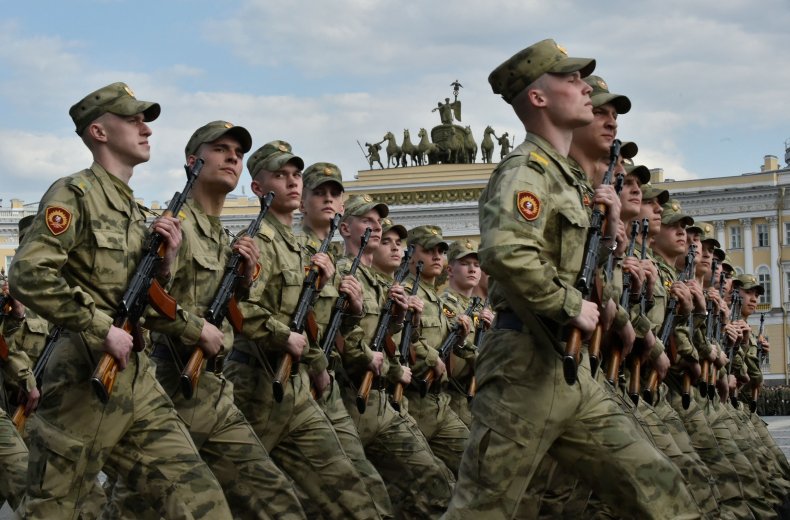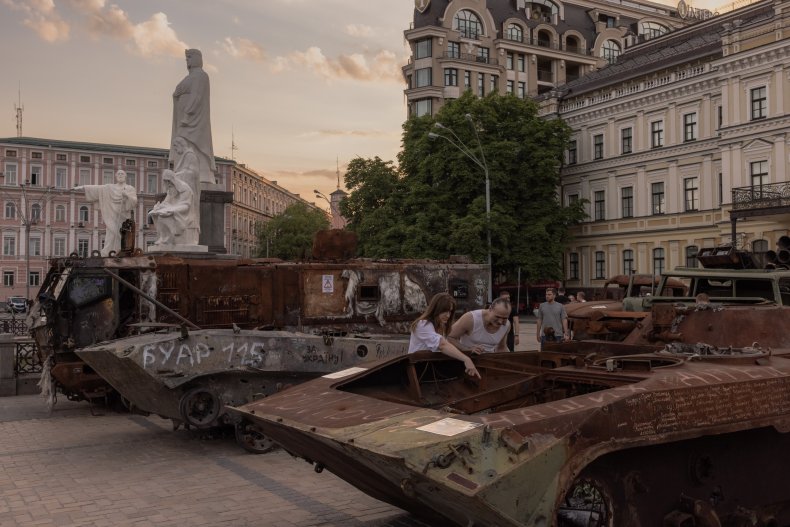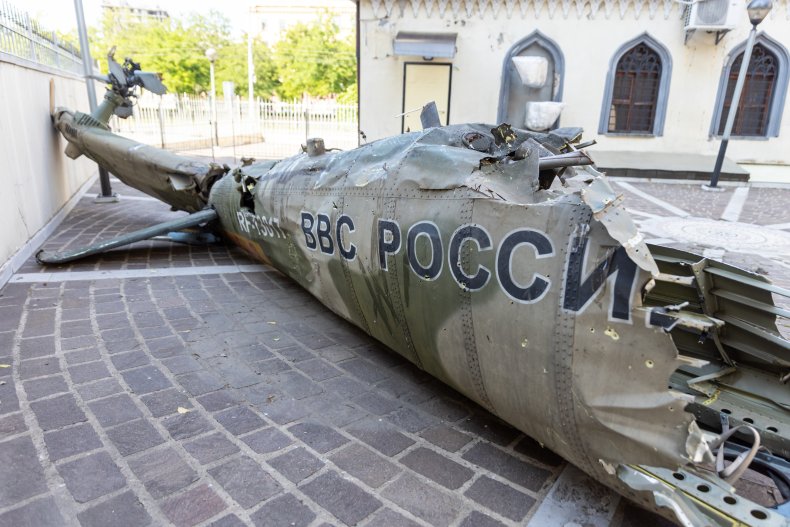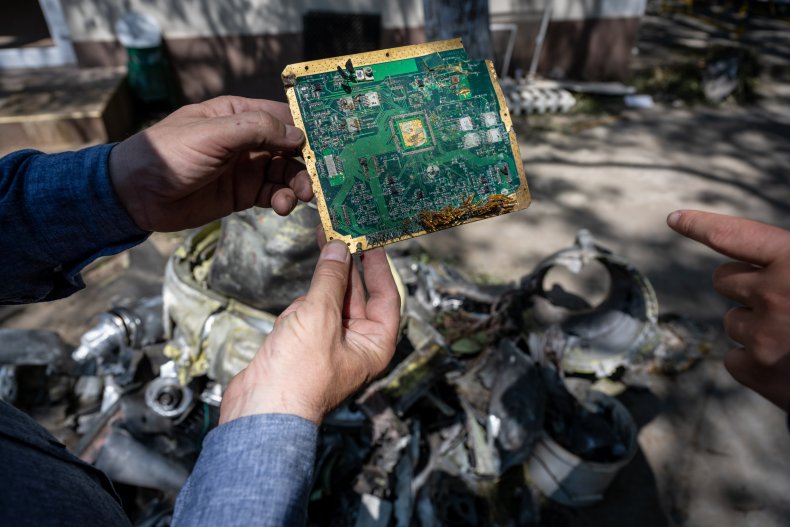DAVID BRENNAN
Some 200,000 people are thought to have been killed in fighting between Russia and Ukraine since February 24, 2022, when President Vladimir Putin opened the latest—and perhaps final—chapter of Moscow's 30-year effort to hinder Kyiv's westward drift and regenerate a neo-imperial sphere of influence.
Putin's military gambit has not gone to plan. The stunning failure of Russia's thunder run on Kyiv in the early days and weeks of the invasion proved a harbinger of Moscow's battlefield struggles. The demands of large-scale, mechanized, 21st century warfare pulled back the veil on Russia's supposedly modernized force, illuminating the kind of corruption and incompetence that have hamstrung Moscow's militaries for years.
Against the odds, Ukraine has survived. Kyiv has been able to liberate around 50 percent of the territory seized by Kremlin forces since February 2022, and has its eyes set on Crimea and the areas of the Donbas region occupied since 2014.
But for all the pain Ukraine's resolute defenders have inflicted on the Russian invaders, Moscow's war goes on. The slow and costly nature of Kyiv's ongoing counteroffensive speaks to the resolve of the Russian military, even after suffering staggering losses. Putin, meanwhile, shows no sign of backing down. Europe's largest conflict since World War II has become a war of attrition.
Russia's initial invasion force numbered around 190,000 troops. Many of those have now been killed, captured, or wounded so badly they can never return to the battlefield. Pentagon documents leaked earlier this year estimated 189,500 to 223,000 Russian casualties as of February, including as many as 43,000 killed.
That number will be higher after another six months of fighting, and Kyiv claims to have "liquidated" 251,620 Russian personnel since February 2022. Newsweek has contacted the Russian Defense Ministry by email to request comment.
The losses have forced the Kremlin to expand its draft. In August 2022, Putin ordered a 13 percent increase in the number of active soldiers—around 137,000 troops—aiming to raise the total to 1.15 million.
A month later, the Kremlin ordered its "partial mobilization," calling up 300,000 reserves. Despite persistent rumors of a second wave, Putin has so far only overseen a gradual expansion and tightening of the draft process as Russian casualties mount. If Moscow was to embark on a second wave of mobilization, Ukraine has estimated it might call up another 500,000 troops.
Russia's armed forces now have around 1.3 million troops, with a goal to expand this to 1.5 million by 2026. The active portion of Russia's Ground Forces is believed to comprise around 550,000 troops, according to the International Institute for Strategic Studies.
The strain of the war on the army is clear. British Defense Minister Ben Wallace said in February that 97 percent of the force was already deployed inside Ukraine, though remained unable to achieve a sizeable battlefield breakthrough.
Numbers alone do not tell the whole story. Russia's regular armed forces have been augmented with auxiliaries of varying quality.
At one end of the spectrum, Wagner Group mercenaries—of which there were around 50,000 at the group's peak before its ill-fated June mutiny—proved the most effective of Russia's forces, though suffered severe casualties among the jailed Russians it recruited in the early stages of the invasion. At the other end, volunteers and forcibly mobilized soldiers from the Russian-occupied provinces in Ukraine have reportedly been given little training and suffered high casualty rates.
 Military cadets take part in a rehearsal for the Victory Day parade in St. Petersburg, Russia, on April 25, 2023. Russia's ground forces have sustained severe casualties in their invasion of Ukraine.OLGA MALTSEVA/AFP VIA GETTY IMAGES
Military cadets take part in a rehearsal for the Victory Day parade in St. Petersburg, Russia, on April 25, 2023. Russia's ground forces have sustained severe casualties in their invasion of Ukraine.OLGA MALTSEVA/AFP VIA GETTY IMAGESRussia's elite forces have been badly mauled. Those who replace them will be less experienced and less motivated, though those who survived the initial stages of the conflict have emerged hardened and likely more effective.
Pavel Luzin, a Russian political analyst and visiting scholar at The Fletcher School of Law and Diplomacy, told Newsweek that the on-paper expansion of Russia's army does not equate to a more robust fighting force.
"Russia is trying to create an illusion of its readiness for the long-term war," he said. "Actually, it is making efforts to get a ceasefire for several years (before the next round of war) and to keep captured territories.
"At the same time, the Russian leadership fears defeat. It is not only a matter of political calculations but also a matter of ideology. In this way, the Kremlin is ready to sacrifice a lot of things and a lot of Russians to avoid the defeat."
Comparing Putin's regime to ISIS forces fighting in the Middle East, Luzin added: "They were not able to win, they were weakening every day. But they were irrationally ready to fight until the very end because of their ideology and fears. The Kremlin is the same."
"However, the Russian army is continuing its organizational and technical degradation; it is an inevitable process," Luzin added. "I don't know whether or not the collapse will happen, but the further degradation of Russia's army is inevitable.
"ISIS wasn't a regular army but resisted till the end. So, Russia may continue to fight even if its army will become irregular. Nevertheless, the longer Russia continues the war, the less opportunities for a sustainable political and economic future it has."
Tanks
Russia's tank fleet has suffered badly in Ukraine. More than 2,000 are thought to have been destroyed or captured, representing around two-thirds of those in active service before the war.
Among these are dozens of T-90 main battle tanks; Russia's most advanced combat-proven platform. The most modern system—the much-hyped but rarely seen T-14 Armata—has been introduced in small numbers but has not played a central role.
The situation appears bleak for Russia's armored divisions, but the central role of the tank in Soviet and Russian military doctrine means Moscow has an enormous stock of mothballed weapons. The Military Balance 2021 database estimated that there were some 10,200 tanks in storage, including relatively modern platforms like the T-72, T-80, and T-90.
The Russian tanks in storage alone represent more than six times the number of fielded Ukrainian tanks. However, given deep-reaching corruption within Russia's armed forces, it is not possible to say how many of these tanks are serviceable.
Moscow has certainly been dipping into its mothballed stock. Many videos and images have emerged during the course of the full-scale invasion showing outdated tanks being sent to the frontlines.
 People look at a destroyed Russian military vehicle on display in the Ukrainian capital of Kyiv on June 17, 2023. Russia has lost thousands of armored vehicles since February 2022.ROMAN PILIPEY/GETTY IMAGES
People look at a destroyed Russian military vehicle on display in the Ukrainian capital of Kyiv on June 17, 2023. Russia has lost thousands of armored vehicles since February 2022.ROMAN PILIPEY/GETTY IMAGESOne of Russia's largest armor storage facilities—the Vagzhanovo depot in Russia's Siberian republic of Buryatia—has seen some 40 percent of mothballed vehicles removed since the start of the full-scale invasion. According to The Moscow Times, the armed forces had around 3,840 armored vehicles stored there in September 2021. By May 2023, only 2,270 remained.
But despite foreign derision at the Kremlin's "museum pieces," even old tanks heading to the front pose dangers for Ukrainian troops. Some have been used as static gun emplacements, while others have been used to deliver vehicle-borne improvised explosive devices (VBIEDs) to Ukrainian positions.
Such efforts might appear desperate to Western publics, but Oleg Ignatov—Crisis Group's senior analyst for Russia—told Newsweek they mean little to most Russians.
"I would say that people don't pay attention to such information," he said.
"People usually don't know about this information," Ignatov added, noting the hold of state media over the vast majority of the national information space.
"Even people in Moscow sometimes don't know that Moscow was attacked," he said, referring to recent drone strikes on the capital.
Artillery
The failure of Russia's three-day war plan meant its traditionally formidable artillery—known as Russia's "god of war"—would be at the fore of the subsequent fighting. Much of the full-scale invasion has been shaped by frontline artillery duels, in which the Ukrainians have often been outnumbered and outgunned.
Kyiv's troops have slowly been closing the gap, increasingly armed with NATO-produced tube and rocket artillery. In Ukraine's ongoing counteroffensive, Russian batteries—and the munitions depots from which they are fed—have been priority targets.
Kyiv claims to have destroyed more than 5,000 Russian guns since February 2022, along with more than 710 multiple-launch rocket systems.
The Ukrainian figures are significantly higher than open-source estimates. The Oryx tracking website has reported the damage or destruction of 107 artillery support vehicles and equipment; 483 units of self-propelled artillery; and 253 MLRS platforms.
The IISS' Military Balance 2023 inventory reported that Russia still possesses 4,458 artillery weapons of various types.
Shell hunger has been a constant for both sides through the full-scale invasion, whether because of logistics issues or purely a lack of available munitions. Russia's pre-war artillery shell stock dwarfed that of Ukraine and its Western partners. Indeed, a central element of Western support for Kyiv has been a historic munition production effort.
The BBC has reported that Russia may have had as many as 16 million shells in storage before the war, though how many are in a suitable state for use is unknown. According to Admiral Sir Tony Radakin—the chief of the British defense staff—Moscow's forces were already facing a "critical shortage" of shells by the end of 2022.
Air Power
Russia's air assets have fared better than its ground assets, but have still sustained significant losses. Moscow's continued inability to establish air superiority over a much smaller Ukrainian air force stands as one of its biggest failures of the full-scale invasion to date. Nearly 18 months into the fighting, Ukrainian airspace remains contested.
Ukraine claims to have downed 315 Russian planes and 312 Russian helicopters. Oryx has identified 76 destroyed and eight damaged aircraft, including 21 Su-34s, 11 Su-30s, and four Su-35s. Oryx has also confirmed the loss or damage of 101 Russian helicopters, among them 40 Ka-52 "Alligator" attack helicopters.
Russia is believed to have around 900 fighter jets and 120 bombers, meaning its losses in Ukraine are a small but significant portion of its total aerial strength. Moscow's failure to ensure air superiority means Russian aircraft are largely operating far from the front, launching long-range munitions against Ukrainian military, infrastructure and civilian targets.
 The tail of Russian helicopter that was shot down in Kherson Oblast is exhibited in the Dnipro History Museum in Dnipro, Ukraine, on June 2, 2023. Russia is thought to have lost scores of helicopters in 18 months of fighting.INFORMATOR.UA/GLOBAL IMAGES UKRAINE VIA GETTY IMAGES
The tail of Russian helicopter that was shot down in Kherson Oblast is exhibited in the Dnipro History Museum in Dnipro, Ukraine, on June 2, 2023. Russia is thought to have lost scores of helicopters in 18 months of fighting.INFORMATOR.UA/GLOBAL IMAGES UKRAINE VIA GETTY IMAGESThe British Ministry of Defence wrote this week: "Over the summer, Russian tactical combat aircraft have typically carried out over 100 sorties a day, but these are almost always restricted to operating over Russian-controlled territory due to the threat from Ukrainian air defenses."
President Volodymyr Zelensky this week lauded the development of Ukraine's anti-air network, which he said has destroyed more than 5,500 objects since the start of the full-scale offensive.
But Moscow's aircraft pose a potent threat to Ukraine, which is still trying to secure access to NATO-made fighter jets.
Long-range Missiles
Russia's arsenal of long-range ballistic missiles is arguably a more pressing threat than Moscow's aircraft. Missile attacks on Ukrainian cities and infrastructure have become commonplace, including strikes on civilian targets like shopping malls and high-rise apartment buildings.
Many of Russia's more modern missiles reportedly rely on foreign technology. The broad Western sanctions campaign on Moscow in response to the February 2022 full-scale invasion was predicted to choke its advanced weapon production capacity, but missiles have continued raining down on Ukrainian targets regardless.
In January, Ukrainian Defense Minister Oleksii Reznikov said that Russia had around 19 percent of its pre-war strategic missile arsenal still available for use. Among those were 144 of the 900 pre-war Iskanders, 59 of the 500 pre-war Kalibrs, 118 of the 444 pre-war Kh-101/555s, and 162 of the 370 pre-war Kh-22/32s. Reznikov said Russian production meant it had 53 available Kinzhal missiles compared with 43 pre-war.
 A man examines the circuit board of a Russian missile that struck a grain storage facility in the village of Pavlivka, in Ukraine's Odesa region, on July 24, 2023. Russian missile attacks on Ukrainian cities have become routine.SCOTT PETERSON/GETTY IMAGES
A man examines the circuit board of a Russian missile that struck a grain storage facility in the village of Pavlivka, in Ukraine's Odesa region, on July 24, 2023. Russian missile attacks on Ukrainian cities have become routine.SCOTT PETERSON/GETTY IMAGESRussia had a larger remaining proportion of tactical missiles, Reznikov said. This included 326 of 470 pre-war Onyx, 6,672 of 8,000 pre-war S-300s, and 312 of 500 pre-war Kh-29/31/35/58/59s.
Russia has continued its long-range strikes in subsequent months, meaning these figures will have been somewhat whittled down. But Moscow has been able to continue production even while Western sanctions bite.
Russia has reportedly been using conduit third countries to import dual-use electronic goods it can cannibalize for required military components. Vladyslav Vlasiuk, an adviser to Zelensky on sanctions policy, told Reuters in April that Kyiv is now finding more Chinese components inside Russian missiles.
Naval Forces
Despite some high-profile losses, Russia's navy is largely unscathed. Only the Black Sea Fleet has been heavily involved in the full-scale invasion, losing its Moskva flagship in the process.
The Slava-class missile cruiser is among eight vessels confirmed destroyed by Oryx, along with five Raptor-class patrol boats, one high-speed assault boat, the Tapir-class landing ship Saratov, one Serna-class landing craft, and rescue tug the Vasily Bekh.
Two Ropucha-class landing ships have been damaged, as has a Natya-class minesweeper. The Admiral Grigorovich-class frigate Admiral Makarov was also claimed damaged by Ukraine in a naval drone attack last year.
Russia still has the third-largest navy in the world behind the U.S. and China, according to the World Directory of Modern Military Warships' 2023 database. Among its assets are one aircraft carrier, 58 submarines, four cruisers and 12 destroyers.
No comments:
Post a Comment